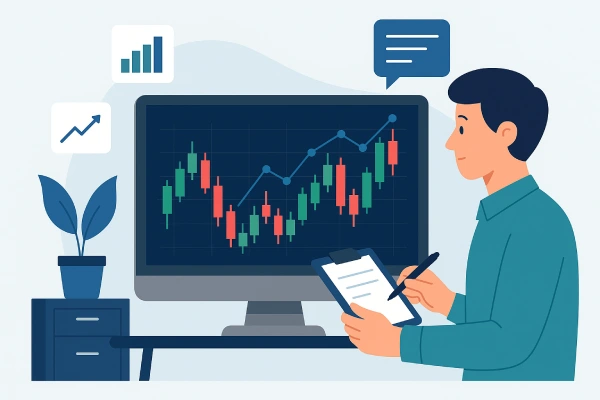How to Analyze the Forex Market: A Simple Guide for Smart Traders
Forex Analysis Methods
"Learn how to analyze the forex market like a pro. This guide will explain the three principal forex analysis methods, technical, fundamental, and sentiment analysis to help you trade with confidence.""
Wikilix Team
Educational Content Team
12 min
Reading time
Beginner
Difficulty

If you've ever wondered how traders make decisions in the fast-paced world of forex, they do it through analysis. Every trade you see, every prediction made, every information gathering, and every successful strategy was rooted in a form of market analysis. Additionally, not all traders rely on the same form of analysis. Some traders are chart and pattern traders, others are news traders, and some follow the crowd. Each provides new information, and it is essential to know the difference so you don't go in blind (i.e., as in the case with chart trading) or just unthinkingly 'guessing'. In this article, we will explain the three main types of forex market analysis in somewhat easier-to-read terms — without going highbrow or too technical jargon, just raw information you can use. This is the starting point of many a more thoughtful trading journey, whether you are just beginning or looking to refine your trading skills.
The Importance of Market Analysis in Forex Trading
Before discussing analysis types, it is helpful to consider why analysis is essential. The foreign exchange (forex) market is one of the most unpredictable and volatile financial markets in which to engage in trading. Currency movements can be influenced by a range of factors, including economic events, geopolitical developments, and the sentiment of traders and market participants on a given day. Trading plays itself the same way a casino game plays itself, without a proposition to help rationalize these moves.
Market analysis provides traders with a systematic way to interpret what is happening, what is likely to happen next, and how to prepare for that. It helps to minimize emotion-based decisions by reintroducing rationality into your trading. It can be used for both long-term trades and shorter-term trading; analysis enables you to make sense of everything, providing a stronger foundation than simply playing the market arbitrarily.

The Three Main Forms of Forex Market Analysis
Forex traders rely heavily on only three methods of analysis:
• Technical Analysis
• Fundamental Analysis
• Sentiment Analysis
Let's have a look at each of them - how they work, what they focus on, and how you can use them properly.
1. Technical Analysis - Reading the Charts
Technical analysis is the most well-known method used by forex traders (especially day and scalpers). Technical analysis is simply the study of price charts and patterns to help identify future price movements.

Essential Elements of Technical Trading:
• Price Action - How the price has moved in the past.
• Trends - Is the market moving up (bullish), down (bearish), or going sideways?
• Support and Resistance - price levels at which the price tends to reverse or bounce off.
• Indicators - Such as Moving Averages (MA), RSI (Relative Strength Index), MACD, and Bollinger bands; indicators help to confirm price direction and strength.
The simple idea behind technical analysis is that history tends to repeat itself. In other words, traders believe that if they see specific market patterns or behaviors in the past, they will see those patterns or behaviors again in the future.
The best thing about technical analysis is that it is visual. Even a novice trader can spot trends and patterns with a bit of practice! Most trading platforms offer charting tools that are easily incorporated into your trading analysis. Making it easy for all traders to access technical analysis.
2. Fundamental Analysis – Understanding the Big Picture
While technical analysis is primarily concerned with "what" is happening in the market, fundamental analysis is concerned mainly with "why" it is happening.
Fundamental analysis is broader and examines the fundamental economic, political, and social factors that drive currency values. This type of analysis is favored by traders seeking to identify the primary forces driving market movements.

Basic Factors in Fundamental Analysis:
• Economic factors: GDP, inflation, interest rates, employment numbers, trade balances.
• Central bank decisions: US Federal Reserve, European Central Bank, Bank of England, etc.
• Geopolitical events: wars, elections, trade agreements, global tensions.
• News releases: Data releases are regular items, usually resulting in an immediate market reaction.
As an example, if the Federal Reserve raises interest rates in the US, it strengthens the US dollar. Why? Higher interest rates typically attract more investment, increasing demand for that currency.
Fundamental analysis tends to be more favored by longer-term traders and investors. Analyzing the fundamental factors requires staying informed about the news and having a working knowledge of global economics, more often than not. Still, it can provide powerful insights where technical indicators do not give the clearest direction.
3. Sentiment Analysis - Measuring the Market Mood
Sentiment is the third type of analysis, reflecting the overall "mood" of the market. Are traders feeling confident and greedy, or are they fearful and cautious?
Sentiment can move prices in ways that technical and fundamental analysis cannot necessarily explain. For example, even if an economic report is positive, if traders were expecting it and are fearful about future events, the currency may still fall, despite the report's favorable outcome.
Here are some ways to measure market sentiment:
• Positioning Report: Data that depicts how many traders are long versus short for a currency.
• Media Headlines: The mood of the financial media may lead to clues about general sentiment.
• Social Media and Forums: Sometimes what people are talking about can signal how the crowd is feeling.
• Volatility Index (VIX): While the VIX is more often used in stock trading, it can signal fear or complacency in all markets.
For many traders, sentiment is the missing link in developing their strategies. Understanding sentiment helps explain why the market doesn't always make sense to traders. It can also allow you to trade in concert with mass psychology.

What Analysis Is Best?
This is a question we hear pretty often — and the honest answer is that there is no right or wrong.
Some traders live and die by technical analysis, and they will never read the news. There are also plenty who will never place a trade without knowing what is on the economic calendar. The best traders use their blend of the three forms of analysis.
Here is one example of how these would fit together:
- Conduct fundamental analysis to understand the whole picture you are tracking (eg, more long-term trends in the economy).
- Conduct technical analysis to identify entry and exit points on the chart.
- Conduct sentiment analysis to determine if a trade is a good idea or if you should sit out the trade.
By combining these techniques, you will have a more complete and balanced view of the market.
Suggestions for Using Each Analysis Type
Here are some suggestions to make the most of each type of analysis:
Technical Analysis Suggestions:
Don't use too many indicators — make your charts clean and simple. • Always identify the trend before looking for entries. • Practice charts on a demo account until you are comfortable.
Fundamental Analysis Suggestions:
Regularly check a reliable economic calendar (i.e., Forex Factory or Investing.com). • Watch speeches and press conferences of central banks — these move markets. • Know that news can have a short-term and long-term impact.
Sentiment Analysis Suggestions:
Be careful when sentiment reaches extreme levels — this can indicate a reversal. • Use sentiment as confirming evidence and not the sole reason for a trade. • Be objective — do not have your discipline affected by the fear or excitement of the crowd.
Common Pitfalls
• Overanalyzing. Using too many tools can confuse and stall your decision-making.
• Ignoring risk management. Even with excellent analysis, you can still lose money without appropriate stop-losses and position sizing.
• Pointless Following the news. Hopping into the market moments after a news release and planning can be harmful.
• Letting emotions get to you. Analysis forces you to think clearly. Don't let fear or greed affect your analysis.
Final Thoughts
Market analysis is the backbone of every good trade. No matter if you are a novice trying to learn or an experienced trader trying to improve your strategy, you need to understand the different types of forex analysis.
Technical analysis tells you what picture is sliding into place. Fundamental analysis tells you the why. Sentiment analysis provides insight into the crowd's reactions. Each one is valuable in its own right. Collectively, they are invaluable and a complete analysis to advance your trading career.
The forex market is more than just numbers and charts; it is a way to sort and act on information with confidence. The more you understand about the types of analysis, the better a trader you will become, and the more consistent you'll feel.
What's Next?
Keep building your knowledge with our structured learning path. Each section builds upon the previous one.
This is the first section
You're at the beginning of your journey!
This is the last section
You've completed this course!
